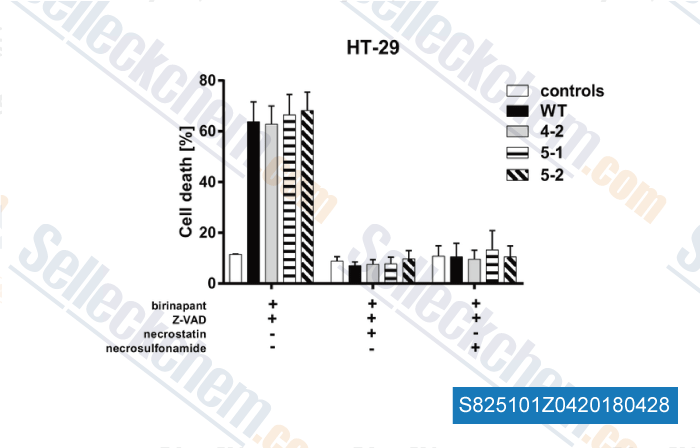|
Toll Free: (877) 796-6397 -- USA and Canada only -- |
Fax: +1-832-582-8590 Orders: +1-832-582-8158 |
Tech Support: +1-832-582-8158 Ext:3 Please provide your Order Number in the email. |
Technical Data
| Formula | C18H15N5O6S2 |
||||||
| Molecular Weight | 461.47 | CAS No. | 1360614-48-7 | ||||
| Solubility (25°C)* | In vitro | DMSO | 92 mg/mL (199.36 mM) | ||||
| Water | Insoluble | ||||||
| Ethanol | Insoluble | ||||||
| In vivo (Add solvents to the product individually and in order) |
|
||||||
|
* <1 mg/ml means slightly soluble or insoluble. * Please note that Selleck tests the solubility of all compounds in-house, and the actual solubility may differ slightly from published values. This is normal and is due to slight batch-to-batch variations. * Room temperature shipping (Stability testing shows this product can be shipped without any cooling measures.) |
|||||||
Preparing Stock Solutions
Biological Activity
| Description | Necrosulfonamide is a very specific and potent necrosis inhibitor and blocks mixed lineage kinase domain-like protein (MLKL). | |
|---|---|---|
| Targets |
|
|
| In vitro | Necrosulfonamide inhibits MLKL-mediated Necrosis by blocking its N-terminal CC domain function. It blocks necrosis downstream of RIP3 activation. This compound has no effect on apoptosis induced by TNF-α plus Smac mimetic in non-RIP3-expressing Panc-1 cells, even at 5 μM concentration. The reason for the species specificity of this chemical is that the cysteine at residue 86 in human MLKL that is covalently modified by it is replaced by a tryptophan residue in mouse MLKL(mixed lineage kinase domain-like protein)[2]. |
|
| In vivo | Necrosulfonamide (NSA) is a small molecule that specifically inhibits necroptosis by targeting MLKL, the terminal executioner of this process. |
Protocol (from reference)
| Cell Assay: |
|
|---|---|
| Animal Study: |
|
References
|
Customer Product Validation

-
Data from [ , , Biochim Biophys Acta, 2018, 1865(3):522-531 ]

-
Data from [ , , Biochem Biophys Res Commun, 2018, 503(3):1550-1556 ]
Selleck's Necrosulfonamide Has Been Cited by 120 Publications
| Cytosolic cytochrome c represses ferroptosis [ Cell Metab, 2025, S1550-4131(25)00149-4] | PubMed: 40233758 |
| Harnessing the FGFR2/NF2/YAP signaling-dependent necroptosis to develop an FGFR2/IL-8 dual blockade therapeutic strategy [ Nat Commun, 2025, 16(1):4128] | PubMed: 40319089 |
| MLKL‒OPTN axis regulates herpesvirus-induced neurological sequelae [ Clin Transl Med, 2025, 15(6):e70353] | PubMed: 40490945 |
| The cancer-associated SF3B1K700E spliceosome mutation confers enhanced sensitivity to BV-6-induced cytotoxicity [ Cell Death Dis, 2025, 16(1):476] | PubMed: 40595498 |
| Androgen receptor inhibition sensitizes glioblastoma stem cells to temozolomide by the miR-1/miR-26a-1/miR-487b signature mediated WT1 and FOXA1 silencing [ Cell Death Discov, 2025, 11(1):248] | PubMed: 40399259 |
| O-GlcNAcylation of glutaminase isoform KGA inhibits ferroptosis through activation of glutaminolysis in hepatoblastoma [ Cell Death Discov, 2025, 11(1):160] | PubMed: 40204725 |
| Neuregulin-1 prevents death from a normally lethal respiratory viral infection [ PLoS Pathog, 2025, 21(4):e1013124] | PubMed: 40267147 |
| WTX-L/β-arrestin2/LCN2 axis controls vulnerability to ferroptosis in gastric cancer [ iScience, 2025, 28(3):111964] | PubMed: 40109379 |
| Corilagin alleviates radiation enteritis through caspase-1/gasdermin D-dependent pyroptosis by targeting aldo-keto reductase family 1 member C2 via glutathione metabolism [ Int Immunopharmacol, 2025, 163:115245] | PubMed: 40674841 |
| MLKL Modulates Necroptosis and Neuroinflammation in a Mouse Model of MS [ Inflammation, 2025, 10.1007/s10753-025-02323-3] | PubMed: 40601171 |
RETURN POLICY
Selleck Chemical’s Unconditional Return Policy ensures a smooth online shopping experience for our customers. If you are in any way unsatisfied with your purchase, you may return any item(s) within 7 days of receiving it. In the event of product quality issues, either protocol related or product related problems, you may return any item(s) within 365 days from the original purchase date. Please follow the instructions below when returning products.
SHIPPING AND STORAGE
Selleck products are transported at room temperature. If you receive the product at room temperature, please rest assured, the Selleck Quality Inspection Department has conducted experiments to verify that the normal temperature placement of one month will not affect the biological activity of powder products. After collecting, please store the product according to the requirements described in the datasheet. Most Selleck products are stable under the recommended conditions.
NOT FOR HUMAN, VETERINARY DIAGNOSTIC OR THERAPEUTIC USE.
